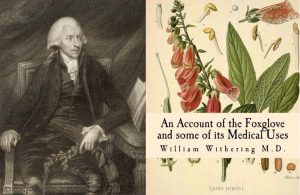Table of Contents
With the winter withering at the Pry House medicinal garden, what a better time to talk about William Withering, the British physician who first described the use of foxglove (Digitalis purpurea) for the treatment of dropsy (congestive heart failure) in 1775. Withering identified the therapeutic effects of foxglove while testing a folk remedy on one of his patients with dropsy. The cardiac glycoside was later isolated in 1875.

Digitalis purpurea is a biennial plant that grows about 3-6 feet tall. The leaves are a basal rosette, ovate to lance-shaped, soft, hairy and toothed. The flowers are purple to white, spotted thimbles 1 ¼” long on spikes. The leaves of the plant from the second year’s growth are the source of the therapeutic digitalis glycosides digitoxin and digoxin.
Although originally grown in Europe, the plant was transplanted in America over 200 years ago. Today it can be bought in home and garden centers and is used as an ornamental plant because of its purple flowers. It is important to remember that foxglove leaves are toxic and care should be used when planting it where children and pets play.
Initially, foxglove was considered a sedative on the nervous and arterial system with diuretic properties and spoken of as a tonic to the heart and arteries. According to the 1883 edition of the Therapeutic Handbook of the United States Pharmacopoeia, digitalis primarily influences the heart and arteries; in small doses it reduces the frequency and increases the force of the heart’s beat, rendering the pulse slower and firmer to produce a healthy degree of contractility in the arteries. The indications for its use are most frequently met with in valvular disease, but it may be of value in almost any instance where the beat is feeble and irregular and the circulation is sluggish.

Period editions of the United States Pharmacopoeia and United States Dispensatory recommend doses of 1- 2 grains (60-120 mg) two to three times daily and gradually increased until some effect is produced on the head, stomach, pulse or kidneys, when it should be omitted or reduced. They state that an odd aspect of digitalis is that after having been given in moderate doses for several days without an effect, its accumulation in the bloodstream sometimes acts suddenly, endangering life. It is moreover, very permanent in its operation, one dose, is maintained for a considerable period without added doses of the medicine.
The inferences 19th century physicians made based on their knowledge of digitalis were, first, that, after it has been dosed for some time without an effect, care should be taken not to increase the dose too greatly; and secondly, that, after its effects have begun to appear, it should be suspended for a time, or exhibited in smaller doses, lest a dangerous accumulation should be experienced. Wythes’ Pocket Dose and Symptom Book states that for therapeutic purposes, smaller doses are usually used. Larger doses of digitalis cause vomiting, diarrhea, flashes before the eyes and an irregular pulse finally giving rise to a feeble pulse and death. In over-doses, it occasions vomiting, purging dimness of sight, vertigo, delirium, hiccough, convulsions and death.
Let’s look at a Civil War related example of how digitalis might have been used. Modern interpretations of Robert E. Lee’s cardiac history suggest that he suffered from exertional chest pains (angina pectoris) and may have suffered a heart attack in March 1863.Throughout the period from 1863 until his death in 1870 his description of his physical condition indicates the progression of cardiac disease. The description of Lee’s last few weeks between September and October 1870 by his doctors Howard Barton and Robert Madison suggest he had symptoms of heart failure, the end result of advanced cardiac disease. Digitalis might have been prescribed for him if his symptoms of shortness of breath, rapid feeble pulse, and cool extremities would have been attributed to a failing heart.
Modern day uses for digitalis include slowing the heart rate in a condition of an irregular heart rate known as atrial fibrillation and to strengthen the force of the heart’s contraction and improving heart failure symptoms in patients with congestive heart failure. The most commonly used product is digoxin (Lanoxin®).
Some say medicine is more art than science. Let’s take a moment and see how medicine may have impacted art. Vincent van Gogh, the Dutch postimpressionist painter’s paintings were characterized by halos and the color yellow such as in his painting Starry Night.

Many have ascribed this to the fact that Van Gogh may have been influenced by digitalis intoxication and its side effects: xanthopsia; a visual defect in which objects are seen as yellow and coronas. This is based on his paintings of his physician Dr. Gachet holding a foxglove plant. Gachet treated van Gogh’s epilepsy with digitalis and the toxic effects of digitalis may have, in part, dictated the artist’s technique.
Next time we will be moving from art to music as we discuss the Stevie Nicks of medicinal plants; belladonna.
This is the third in a series of posts about the Pry House Medicinal Garden. Click below to be directed to the others.
Part One Part Two Part Four part five part six part seven part eight
About the Author
Greg Susla has been a volunteer at the National Museum of Civil War Medicine since January 2011. Greg’s interest in the Civil War stems from his home town, Torrington, CT, the birth place of the abolitionist John Brown. Greg received his pharmacy degrees from the Universities of Connecticut and Florida and completed a critical care pharmacy residency at the Ohio State University Hospitals. Greg spent the majority of his career as the ICU pharmacist at National Institutes of Health in Bethesda, MD and volunteered his time in the ICU at the National Naval Medical Center in Bethesda, MD. Greg has been active in the Society of Critical Care Medicine for over 25 years serving on a number of the Society’s committees, and is a Fellow in the American College of Critical Care Medicine. Greg recently retired as the Associate Director of Medical Information at MedImmune in Gaithersburg, MD. Greg is leading the restoration of the garden and is being assisted by his wife Lisa and other staff members and volunteers at the Museum and Pry House. Greg and his wife Lisa live in Frederick, MD.



Leave a Reply
You must be logged in to post a comment.